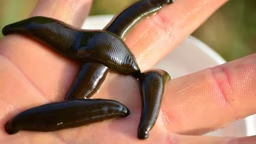Even most North American terrestrial turtles head for an underwater berth. How can an air-breathing reptile submerge its entire body and survive without coming up for air for four months or more? The answer, it turns out, has to do with some unusually efficient turtle physiology and the behavior of water itself.
Cool and dense. Water is an amazing substance. Unlike most compounds, it is less dense as a solid than as a liquid. At 39 degrees Fahrenheit, fresh water is at its most dense or heaviest. Any warmer or any cooler, and the water is lighter.
As a body of water begins to freeze in the winter, water sinks to the bottom as it cools down to 39 degrees Fahrenheit. Colder and warmer waters, which are lighter, are displaced. Thus, the temperature on the bottom remains constant through the winter, kind of like a sleeping bag that is rated to 39 degrees Fahrenheit and suitable for under-water creatures. Colder water rises until it reaches 32 degrees on the top. There, ice forms, sealing in the temperature gradients below.
The unique properties of water create a snug climate on the bottom for turtles and other aquatic hibernators. But a turtle has lungs and still has to breathe.
If not gills, then what? If the water were warmer, turtles would consume more oxygen. If it were much colder, turtles would freeze. On top of all that (literally), ice prevents hibernating turtles from swimming
to the top to gulp air.
It helps that colder water traps and holds more dissolved oxygen than warmer water, but for turtles that is not enough for extended underwater living. Turtles still need small amounts of oxygen in order to survive. Here’s where their unique physiology comes into play.
Because their lungs are essentially useless under water, turtles obtain their oxygen from the water, not through gills like fish, but through two specialized structures. Moist membranes lining their throat cavities and two thin-walled sacs located near their anuses allow them to absorb oxygen directly from the water.
How Low can it go? Essential to a turtle’s ability to remain under water for months at a time is its ability to lower its metabolism on a cellular level to an extremely slow, steady state. For example, a turtle whose heart rate is approximately 40 beats per minute in warm weather may have a hibernating heart rate of approximately one beat every 10 minutes.
However, even with this low metabolic activity level, the turtle’s bodily functions can still produce enough lactic acid in its bloodstream to kill it.
This is where the turtle’s shell comes in. The shell is not only a means of physical defense against predators, it is also a built-in defense against the buildup of lactic acid during hibernation.
The shell releases minute amounts of calcium salts into the bloodstream to counteract the lactic acid – and the shell slowly absorbs lactic acid and neutralizes it. Researchers also have discovered that these calcium salts serve an additional function by keeping the turtle’s oxygen-starved heart pumping on schedule.
Just like us? So now you know where those turtles swimming under your dock and basking in the sun go in the winter. In the fall, they put on extra fat and lower their body temperature and activity level. At about 40 to 50 degrees Fahrenheit, they become sluggish, stop eating and crawl into the mud on the bottom of the lake.
While we are going to great lengths to lay up our pipes at the cabin and winterize our boat engines, nature alters the cells of hibernating turtles with its own form of antifreeze.
If it hasn’t been too rough a winter, come late spring, our pipes don’t leak, our engines start and turtles slowly come to life ready to bask in the sun for another season.
Freelancer Nancy Cain hibernates the winter away in front of her woodstove in Vermont.











